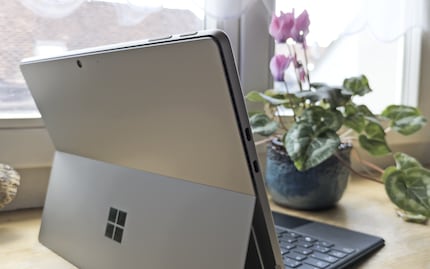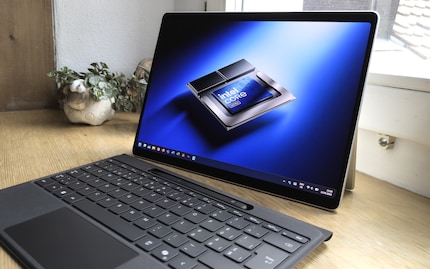
Product test
Fanless, purple 12-inch Microsoft Surface Pro review: generally good, but…
by Martin Jud

When tested, the Microsoft Surface Pro for Business with Intel chip convinced me more than the cheaper Qualcomm version. This is due to its better battery life and graphics performance. Nevertheless, there is one point apart from the price where Qualcomm has the edge.
Microsoft offers its Surface products in both consumer and business versions. The devices, which are actually intended for companies, are not normally of interest to private consumers due to their higher price. However, the Surface Laptop and the 11th edition of the convertible Surface Pro are only available in the business version with an optional Intel processor.
Since the hardware is practically identical apart from the chip, a comparison between the version with Qualcomm's Snapdragon X and the new one with Intel Core Ultra (Series 2) is obvious. I have included the test results of the Asus Zenbook S 16 in the graphics so that AMD's Ryzen AI 300 is also in the mix.
Apart from the fact that the Intel variant is only available in the business version, a Microsoft business device differs primarily in the following points:
To test the processor performance, I rely on Geekbench 6 and Cinebench 2024.
Intel's new CPUs no longer have hyperthreading - i.e. one core only serves one thread instead of two. For this reason, and because it has fewer cores (eight vs. twelve) than the competition, it is already clear in advance that the Core Ultra chip is at a disadvantage compared to Snapdragon and Ryzen in multi-threaded benchmarks. However, this is not tragic for most applications apart from benchmarks and rendering, as very few programmes use more than eight threads.
In the single-core result, the results from Intel and Qualcomm are practically identical. AMD follows close behind. In multi-core, the Snapdragon of the consumer Surface Pro takes the crown. The Ryzen installed in the Zenbook follows with 6.4 per cent less performance. The Core Ultra of the business device has to admit defeat with 23.2 per cent less performance.
In the Cinebench results, AMD is ahead in the multi-core category:
The Ryzen is better suited for rendering 3D content than its competitors. The gap to Intel in multi-core is 37.9 per cent. Otherwise, the picture is similar to Geekbench.
In terms of pure CPU performance, the business device is therefore at a slight disadvantage. But raw multi-core processor power is not all that makes a good computer. And according to these two benchmarks, the tide is turning in Intel's favour compared to the consumer Surface Pro.
To test the iGPU of the three competitors, I run the Geekbench 6 graphics test with OpenCL and Vulkan API. I also render images with 3DMark Wild Life Extreme Unlimited.
The AMD Radeon 890M leads the way. Using OpenCL, Intel's Arc 140V achieves 22.7 per cent less performance. Using the Vulkan API, the gap is only 7.1 per cent. Qualcomm's Adreno iGPU brings up the rear with 42.8 per cent (OpenCL) and 40.3 per cent (Vulkan) less performance compared to AMD.
In 3DMark Wild Life Extreme Unlimited, the consumer Surface Pro is still in last place. However, it is only 15.1 per cent behind the best result. In this application, the Intel iGPU has an 8.7 per cent advantage over AMD.
I use 3DMark Fire Strike to test how well the devices perform when gaming in 1080p resolution using DirectX 11. You can see a blue overall score, green graphics values, yellow CPU values and a combined score in the graph.
Intel leads the Fire Strike Score with 5.4 per cent more points than AMD. Qualcomm follows in last place with 35.1 per cent fewer points than Intel.
To find out how many frames per second (FPS) are possible in a game, I run the benchmark from «Red Dead Redemption 2». For the resolution, I select the resolution that matches the 3:2 and 16:10 displays on all devices, which is closest to 1080p: 1920 × 1200 pixels (WUXGA). The graphics settings are all set to «Medium» and a number of super-resolution functions are inactive. Vulkan is used as the graphics API:
When using DirectX 11, the Intel iGPU had an advantage. Using the more modern Vulkan API, however, it runs better with the AMD iGPU.
In the video test, the same video is always played locally until the battery is empty. The Office test aims to achieve a «realistic task balance of writing, web browsing and video conferencing, separated by short idle times». The gaming test «puts the system under a constantly high load» by running the «Fire Strike Gaming Benchmark» in a continuous loop. It determines the lower limit of the runtime with one battery charge.
Unfortunately, only the PCMark 10 video battery life test is available for the consumer device with Snapdragon due to the Arm architecture. Therefore, there is only one bar to marvel at in the results graphic:
The battery life of the consumer Surface Pro with Qualcomm chip is also good. However, due to the identical innards and battery capacity of 53 watt hours apart from the chip and motherboard, it is clearly less efficient than the business device. Instead of 15 hours of video, there are only 13 hours here.
For companies, the added value offered by the business versions of Microsoft's Surface devices can certainly justify the price. For private individuals, however, a 51 per cent surcharge is a lot of money. However, the business-exclusive Intel version is undoubtedly better.
The Intel model is superior to the Qualcomm version of the Surface Pro in almost all test points. The Snapdragon X Elite X1E-80-100 can only outperform the Intel Core Ultra 7 268V when it comes to pure CPU multi-core tasks. Intel is the better choice for pure graphics tasks, gaming, fan noise and especially battery life. And since you get a chip with x86 architecture from Intel, there are no programmes that cause compatibility problems. Although this has improved considerably with Qualcomm, not even half of the Adobe suite runs on it, for example.
I think it's a shame that there is no AMD Surface Pro. If there was one, I would prefer it to one with an Intel chip. This is because their latest iGPUs deliver better performance using modern graphics APIs. Graphics are the weakest link in lightweight mobile devices.
Pro
Contra
I find my muse in everything. When I don’t, I draw inspiration from daydreaming. After all, if you dream, you don’t sleep through life.
If you opt for the business version with Qualcomm, you will pay a surcharge of 51 per cent compared to the consumer version with Qualcomm. According to the Swiss Microsoft website, the 13-inch Surface Pro is currently available from CHF 759 and theSurface Pro for Business from CHF 1149. If I compare this with Microsoft's price for the Surface Pro for Business with Intel chip, the fun starts at 1433 francs. Compared to the 13-inch Snapdragon consumer version, this is an increase of 88.8 per cent.
This test device is the best-equipped Surface Pro for Business. It contains an Intel Core Ultra 7 268V (CPU with 8 cores, up to 5 GHz, 12 MB cache, 8-37 watts TDP) with a sufficiently powerful NPU (up to 48 TOPS) to guarantee the Microsoft standard at «Copilot+ PC». An Intel Arc 140V is available as an iGPU with the chip, which clocks at up to 2 GHz and should achieve up to 66 TOPS. The RAM is 32 gigabytes and there is also a terabyte of storage.

The 13-inch OLED touch display offers a resolution of 2880 × 1920 pixels (267 PPI) in a 3:2 aspect ratio, a refresh rate of 120 hertz and features Corning Gorilla Glass 5. It shines brightly with SDR content up to 600 nits and has a peak luminance of 900 nits with HDR. It's fun to work with and great fun to watch films on. But it also pushes up the price. If you want the best equipment, it currently (mid-May 2025) costs around 2500 francs or 2650 euros. On top of this, as with the consumer version, there is the price of a magnetically attached keyboard and possibly the pen. The keyboard is available with or without a pen tray and with or without a pen.

There is also a business keyboard version that can not only charge the pen, but also has a battery and Bluetooth. This means you can also use the keyboard separately from the device, which I do with this sample of the «Surface Pro Flex Keyboard for Business with Slim Pen». This Surface keyboard currently costs around 290 francs/euros including the pen.
The device differs from the best consumer Surface Pro equipment in terms of the motherboard and chip used. Before testing, I am curious to see how the Intel chip with eight cores will fare against the Snapdragon X Elite X1E-80-100 with twelve cores in the following benchmark tests. The Intel chip already has one major advantage in advance: all Windows programmes in the world are natively programmed for it. On devices with a Qualcomm chip and Windows for Arm processors, on the other hand, some apps have to be emulated and others are not available at all - or not yet (see windowsonarm.org).
And so the Asus Zenbook S 16 is best suited for playing «RDR2» with an average of 46 FPS. Since the image never drops below 30 with a minimum of 34 FPS, it is always smooth. There are occasional outliers upwards - up to 97 FPS. The business Surface Pro also never drops below 30 FPS and is just as suitable for gaming with an average of 42 FPS. However, the consumer Surface Pro is at least unsuitable for «RDR2», as there are repeated frame rate drops down to 2 FPS. The fact that the average frame rate is 30 FPS doesn't help either.
With PCMark 10 Professional Edition, the battery performance can be tested using various scenarios standardised (200 nits brightness, Wi-Fi and co. deactivated). I tested the battery life with the profiles «Video», «Modern Office» and «Gaming».
The Business Surface Pro with Intel SoC takes the battery life crown at first glance. It streams 15 hours of video, works for just over 12.5 hours in the office or plays games for an hour and 24 minutes under full load. At second glance, however, it is unclear whether it really performs better than the Asus notebook with AMD SoC apart from the gaming runtime test. This is because the latter has a different battery capacity (78 instead of 53 watt hours) and a larger 16-inch OLED display, which consumes more power. From this perspective, I can only say that both offer excellent battery life.
When working, the device's fan is usually not audible. It's different when I use the CPU and iGPU to their full capacity. I then measure 44.8 decibels with my Testo sound level meter from a distance of 30 centimetres from the device. If I measure from a sitting position, it's 39.4 decibels. This makes it slightly quieter than the Qualcomm version, which measured 45.5 decibels from a distance of 30 centimetres and 39.9 decibels from a sitting position on the test device.

Microsoft Surface Pro 11 for Business
13", 1000 GB, 32 GB, Without keyboard layout, Intel Core Ultra 7 268V